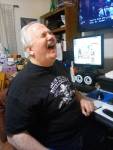Here is a shot from the opposite side.

I was asked recently how do I "fix the flat sided appearance of the brass frets to look round like tubing."
At this scale the flatness of the brass is easy to fix.
You need accelerator, rubber gloves and a breather mask, baking soda. (They are standard on my workbench.)
1. I etched it mildly with "Blackenit" (Model Rail roaders have used this stuff for years.) Wash the parts you have just etched in a stream of warm water and pat dry on a paper towel. The insert the parts into a clear jar and fill half way with baking soda. Put the lid on the jar and turn it over and over in your hands. The baking soda helps neutralize the acidic "Blackenit" residue. The wash it in a stream of warm water again and pat dry with a clean paper towel.
Here you are inhibiting the acid and stopping it from working further.
2. I added accelerator to all of the inside areas / surfaces of the longerons. Let this dry. This not only quick-dries the thin consistancy cyano but thickens it.
3. Then one joint at a time add a small drop of cyano using a clipped sewing needle. Clip the eye of the needle so that it is a two pronged fork. Used the thin cyano. This helps you get the joints only at first.
4. The Part of Poland fuselage frets are joined in sections of at least three with a fourth (usually the turtledeck) separate. Do one vertical side at a time.
5. When a side is tacked in place make sure the longeron edges are at 90 degrees to each other. Then start adding more of the cyano to these inside edges. They will dry quickly so there is little chance of you screwing up later.
This last step fills in the open inside areas between the flat edges. It is almost like laying a caulk between porcelein edges.
6. Add the turtledeck last. When all inside edges are firmly glued with a bead of cyano on the interior angles add accelerator to the outside longeron edges you want to round off and let dry.
7. Now with the same needle modified to a fork drag thin cyano along the outside seams of the mating edges of the longerons. Later you can even go back and add a gel if your looking to make it thicker. I did not think I needed to.
8. Add cyano to the horizontal and veritcal braces between the longerons.
9. After you have completed all four sides of the fuselage skeletal structure, shoot it with a metalizer laquer paint. Usually the laquer is hot enought to etch slightly into the quick dried glue surface. Let this act as a primer. Do this with in an half hour of your completion.
10. Finally shoot with an enamel. You will have to go back an repaint the bracing wires later but that is an quick and esy task. Let it dry in a safe place for about two to three days in a dry moisture free area.
After that inspect your work and see if you need to round out any more edges. (I did not need to.)



























